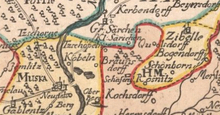Chwaliszowice
| Chwaliszowice | ||
|---|---|---|
 Help on coat of arms |
|
|
| Basic data | ||
| State : | Poland | |
| Voivodeship : | Lebus | |
| Powiat : | Żary | |
| Gmina : | Trzebiel | |
| Geographic location : | 51 ° 35 ′ N , 14 ° 48 ′ E | |
| Residents : | 259 (March 31, 2011) | |
| Telephone code : | (+48) 68 | |
| License plate : | FZA | |
| Economy and Transport | ||
| Rail route : | Lubsko – Bad Muskau railway line | |
| Next international airport : | Poznań | |
| Dresden | ||
Chwaliszowice (German Quolsdorf , more precisely Quolsdorf bei Tschöpeln , 1936–1945 Quolsdorf bei Töpferstedt ; Sorbian Chwałojce ) is a village in the Polish rural community Trzebiel in the district of Żary ( Lebus Voivodeship ).
geography

Chwaliszowice is located off the Droga krajowa 12 , which leads from the German-Polish border crossing Bad Muskau - Łęknica via Trzebiel (Triebel) to Żary (Sorau) . Chwaliszowice is located with a train station on the Lubsko – Bad Muskau railway line in the east wing of the Muskau folds .
From a historical point of view, the village is a Silesian one, bordered by Lower Lusatia in the north and an exclave of the Upper Lusatian class rule Muskau in the east .
history
The village is mentioned in 1498 in a deed of the Duchy of Sagan . In 1543 it was enfeoffed by Duke Moritz von Sachsen to Melcher von der Heide. At the time when the duchy was divided into three districts, the village belonged to the Priebussischer Kreis.
Around 1800 there were nine farms , four gardeners and two cottagers in the village . The residents were parish in the church of Zibelle , where the children also attended school, until the community built its own school in 1913.
In addition to agriculture, two brickworks , two sawmills , a water mill and a slipper factory were commercial employers in the early 20th century .
| year | Residents |
|---|---|
| 1910 | 252 |
| 1933 | 448 |
| 1939 | 400 |
When the Sagan district was dissolved , its western part, including Quolsdorf, came to the Rothenburg district in 1932 .
After the Second World War the village was on the Polish-administered side of the Oder-Neisse line as a result of Poland's shift to the west . Together with most of the other communities in the eastern part of the Rothenburg district, the community now called Chwaliszowice came to the powiat Żarski , which arose from the Polish part of the Sorauer district . From 1950 until it was dissolved by the Polish administrative reform of 1975, the district belonged to the Grünberg Voivodeship , which was made smaller during the reform. Since the reintroduction of the districts on January 1, 1999, Chwaliszowice is again in the Żary district ( Lubusz Voivodeship ).
Place name
Documented name forms include Khulsdorf (1526), Kolsdorf (1529), Kohlsdorf (1543), Quolßdorff (1666) and Quolsdorff (1745). To better distinguish it from Quolsdorf near Mellendorf, the place was also called Wendisch-Quolsdorf, later Quolsdorf near Tschöpeln prevailed. After the renaming of the place Tschöpeln in Töpferstedt in the time of National Socialism , the name addition of Quolsdorf was adapted.
The Polish place name is based on the Sorbian, which was passed down as Chwaloize . This is made up of Chwalish 'praise, praise' and oyze 'village'. According to another opinion, the name is derived from Chwalo , which is a short form of the personal name Boguchwal 'Gottlob'.
literature
- Robert Pohl : Priebus and the villages of the former Sagan western part. 2nd part of the home book of the Rothenburg district O.-L. Buchdruckerei Emil Hampel, Weißwasser O.-L. 1934, p. 32 f .
Individual evidence
- ^ CIS 2011: Ludność w miejscowościach statystycznych według ekonomicznych grup wieku (Polish), March 31, 2011, accessed on May 28, 2017
- ^ Johann Adam Valentin Weigel: The principalities of Sagan and Breslau . Himburgische Buchhandlung, Berlin 1802, p. 24 ( Digitized on Wikisource - Geographical, natural history and technological description of the sovereign Duchy of Silesia 6).
- ↑ Municipal directory Germany 1900. Retrieved on June 21, 2009 .
- ^ Michael Rademacher: German administrative history from the unification of the empire in 1871 to the reunification in 1990. Rothenburg district (Upper Lusatia). (Online material for the dissertation, Osnabrück 2006).

